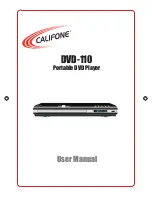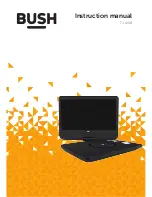
18
GENERATOR
!
WARNING
NEVER exceed the rated wattage capacity of your generator. OVERLOADING may
cause SERIOUS DAMAGE to the generator and attached electrical devices and may
result in fire.
Your generator MUST BE SIZED PROPERLY to provide both the running and starting (surge) wattage of the devices you will be powering.
Before using your generator, determine the running and starting wattage requirements of all the electrical devices you will be powering
simultaneously. Following below 4 simple steps and example on the right:
Step 1. Determine the tools and appliances you want to power at the same time
Step 2. List the start up and running power usage (Watts) for each product
Step 3. Add the total power usage and add 10% as a safety net
Step 4. Choose a generator with a rated and maximum power that equals or exceeds your totals
In this case a generator with a rated power of at least 3108W and a maximum power output
greater than 7233W would be required.
STARTING POWER CONSUMPTION
Electronic appliances and brushed motors generally will not draw more than running Watts
at start up. Induction motors in equipment like air conditioners, welders, water pumps and
compressors can draw 2 to 5 times their running power to start. Please consult your equipment’s rating label, manual or the manufacturer to
confirm specific requirement.
If only the running wattage is given on the nameplate for a device with an electric motor, the starting wattage
can be approximated to be three to five times the running wattage. Estimates for the running wattage requirements for common devices are
listed in the table below. Guidance for starting wattages is provided in the table’s footnotes.
To size your generator correctly you need to use Watts - here are some useful calculations: Watts = Volts x Amps Example 240 Volts x 5 Amps =
1200 Watts
DEVICE
RUNNING WATTS
DEVICE
RUNNING WATTS
Air conditioner (12.000 BTU)
1700 (a,b)
Jet pump
800 (a)
Battery charger (20 Amp)
500
Lawn mower
1200
Belt sander (3”)
1000
Light bulb (100 Watt)
100
Chain saw
1200
Microwave oven
700
Circular saw(6½”)
2000 (a,b)
Milk cooler
1100 (a)
Coffee maker
1800 (a,b)
Oil burner on furnace
300
Compressor (1 HP)
1400 (a,b)
Oil-red space heater (140,000 Btu)
400
Compressor (3/4 HP)
1800 (a)
Oil-red space heater (85,000 Btu)
225
Compressor (1/2 HP)
1400 (a)
Oil-red space heater (30,000 Btu)
150
Curling iron
700
Oven
4500
Dishwasher
1200
Paint sprayer, Airless (1/3 HP)
600 (a)
Edge trimmer
500
Paint sprayer, Airless (handheld)
150
Electric nail gun
1200
Radio
200
Electric range (1 element)
1500
Refrigerator
600 (b)
Electric skillet
1250
Slow cooker
200
Furnace fan (1/3 HP)
1200 (a)
Submersible pump (1-1/2 HP)
2800 (a)
Freezer
800 (b)
Submersible pump (1 HP)
2000 (a)
Hair dryer
1200
Submersible pump (1/2 HP)
1500 (a)
Hand drill (1”)
1100
Sump pump
600 (a)
Hand drill (3/8”)
500
Television
500
Hedge trimmer
450
Toaster
1000
Home computer
150
Vacuum cleaner
250
Kettle
2400
Water heater
3000
(a) Hard-starting motors require 3-5 times the rated running watts
(b) For extremely hard to start loads such as air conditioners and air
compressors, consult the equipment dealer to determine max wattage
















































